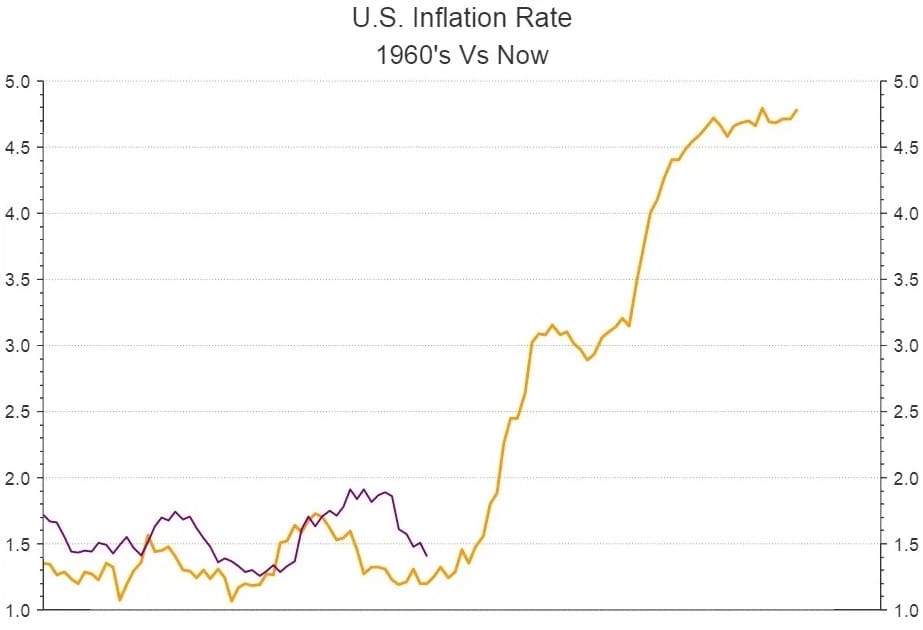Inflation rates have increased dramatically in the past three years, inconsistent with the past 60+ years. Graphic image courtesy Thomas Reuters.
The Rate of inflation has slowed this year but that doesn’t mean it is low or lower. Inflation rates are compounded monthly so if an item increased last month, a year ago, or a decade ago the amount of inflation is added to the new price and compounded. Thus you have a net dollar increase every single month on the same items.
For example and simplicity, if an item costs $10 and inflation is 10%, that item will cost $11 after inflation. Now, take that same item at the new price of $11 and at the same rate of inflation of 10% and the item jumps to $12.10 after inflation. Again, the same item at the new price of $12.10 and same inflation rate would be $13.31 after inflation. You can see where that is going. That’s compound interest. That’s what has happened to the US over the past three years! Compound interest has eaten away what money most people thought they had.
As an example of how inflation affects prices on basic food or grocery items on a year by year or decade view check the following historical records. Some of the information for the following historical food prices was gathered from Stacker. All inflation rates were recalculated by The Standard in today’s dollars.
1960
Fresh eggs (1 dozen): $0.57 ($5.86 in today’s dollars)
White bread (1 pound): $0.20 ($2.05 in today’s dollars)
Sliced bacon (1 pound): $0.66 ($6.78 in today’s dollars)
Round steak (1 pound): $1.06 ($10.89 in today’s dollars)
Potatoes (10 pounds): $0.72 ($7.40 in today’s dollars)
Fresh delivered milk (1/2 gallon): $0.52 ($5.34 in today’s dollars)
The Federal Reserve began slowly raising interest rates following the end of the previous recession in 1958, leading to another short-lived recession in April. Over the course of the next 10 months, the GDP dropped by nearly 2% and unemployment rose to 6.9%.
1970
Fresh eggs (1 dozen): $0.61 ($4.78 in today’s dollars)
White bread (1 pound): $0.24 ($1.88 in today’s dollars)
Sliced bacon (1 pound): $0.95 ($7.45 in today’s dollars)
Round steak (1 pound): $1.30 ($10.19 in today’s dollars)
Potatoes (10 pounds): $0.90 ($7.05 in today’s dollars)
Fresh delivered milk (1/2 gallon): $0.66 ($5.17 in today’s dollars)
1980
Fresh eggs (1 dozen): $0.84 ($3.10 in today’s dollars)
White bread (1 pound): $0.51 ($1.88 in today’s dollars)
Sliced bacon (1 pound): $1.46 ($5.39 in today’s dollars)
Round steak (1 pound): $2.77 ($10.22 in today’s dollars)
Potatoes (1 pound): $0.19 ($0.70 in today’s dollars)*
Fresh grocery milk (1/2 gallon): $1.05 ($3.88 in today’s dollars)
In 1980, the BLS transitioned to tracking the price of one pound of potatoes instead of 10 pounds.
The Iranian Revolution of 1979 paired with restrictive monetary policies aimed at lowering inflation plunged the country into another six-month recession, starting in January. Frustrated with Jimmy Carter and the Democrat’s handling of the economy, Americans voted for Ronald Reagan in the November elections.
2000
Fresh eggs (1 dozen): $0.91 ($1.61 in today’s dollars)
White bread (1 pound): $0.93 ($1.64 in today’s dollars)
Sliced bacon (1 pound): $3.03 ($5.35 in today’s dollars)
Round steak (1 pound): $3.24 ($5.72 in today’s dollars)
Potatoes (1 pound): $0.38 ($0.67 in today’s dollars)
Fresh grocery milk (1 gallon): $2.78 ($4.91 in today’s dollars)
2020
Fresh eggs (1 dozen): $1.53 ($1.80 in today’s dollars)
White bread (1 pound): $1.43 ($1.68 in today’s dollars)
Sliced bacon (1 pound): $5.52 ($6.49 in today’s dollars)
Round steak (1 pound): $6.58 ($7.73 in today’s dollars)
Potatoes (1 pound): $0.83 ($0.98 in today’s dollars)
Fresh grocery milk (1 gallon): $3.28 ($3.85 in today’s dollars)
Are the above prices consistent with what you are paying at the grocery store? If not, what are you paying for these basic food stuffs? Are the prices you are paying consistent with long term inflation over decades? Are the prices you are paying higher, lower or the same as estimated in 2020 dollar valuation for inflation? Please leave a comment below and let me know.
If you’ll look at the inflation rate and price increases above since 1960 they are fairly consistent. That is, until you get to the past three years. The past three years are totally inconsistent with the steady rate of inflation since 1960.
Obviously we know that some factors have changed such as the advent of Covid-19, thousands of cattle and poultry businesses suddenly caught fire and then the movement by governments to shut down and destroy herds and poultry across the country and globe due to the “danger” of methane gas emitted from cattle.
This would also include the idea of “global warming” or “climate change” that is trending around the globe because of a Communist agenda to control people by controlling food supply. This is not my opinion, but rather a stated fact by globalists who seek to control populations and their movements. Even former US Secretary of State Henry Kissinger stated the same: “Who controls the food supply controls the people; who controls the energy can control whole continents; who controls money can control the world.” — Henry Kissinger (1973)
And we didn’t even talk about the lesser quality of the actual food.





 RSS - Posts
RSS - Posts